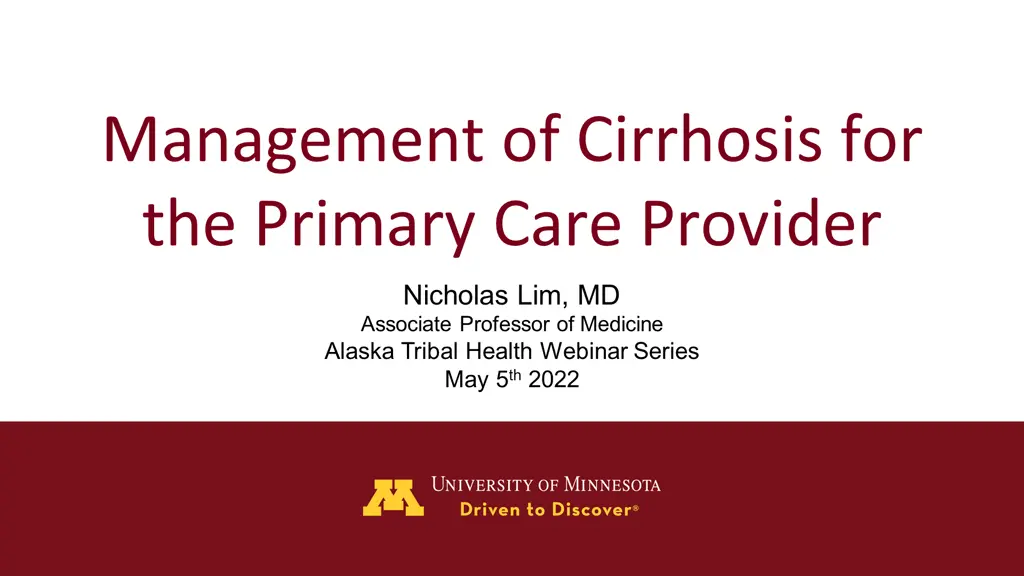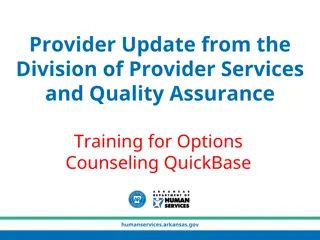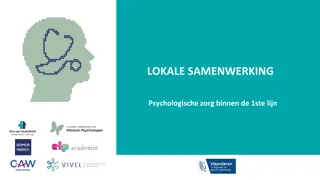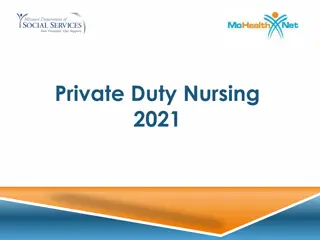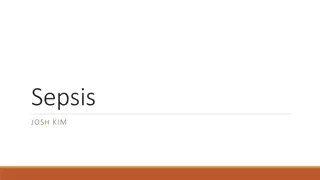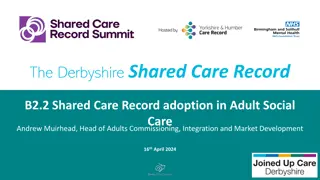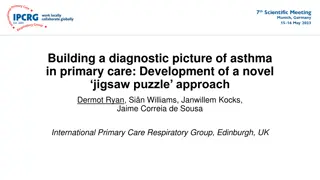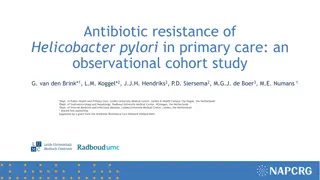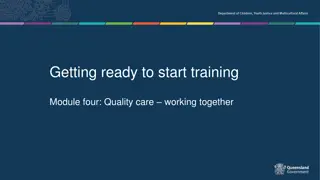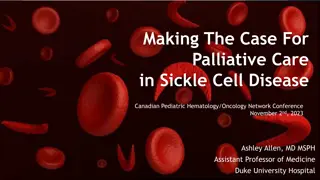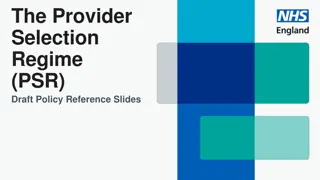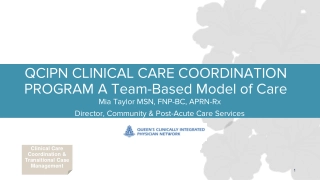Management of Cirrhosis for the Primary Care Provider
Learn about the diagnosis, screening needs, and indications for liver transplant evaluation in patients with cirrhosis. No financial relationships or discussion of off-label medication use or investigational drugs.
Download Presentation
Please find below an Image/Link to download the presentation.
The content on the website is provided AS IS for your information and personal use only. It may not be sold, licensed, or shared on other websites without obtaining consent from the author. Download presentation by click this link. If you encounter any issues during the download, it is possible that the publisher has removed the file from their server.
Presentation Transcript
Management of Cirrhosis for the Primary Care Provider Nicholas Lim, MD Associate Professor of Medicine Alaska Tribal Health Webinar Series May 5th 2022
Disclosures No Financial Relationships No Discussion of Off-label Medication Use or Investigational Drugs
Learning Objectives Upon completion of this activity, participants should be better able to: Describe the diagnosis and natural history of cirrhosis Identify screening needs for patients with cirrhosis Summarize the indications for liver transplant evaluation in patients with cirrhosis
Overview Cirrhosis Basics Screening in Patients with Cirrhosis Liver Transplantation
Definition Cirrhosis (Greek)- yellow/tawny Clinico-pathologic syndrome characterized by diffuse hepatic fibrosis resulting in nodule formation, disruption of hepatic architecture resulting in altered hepatic function and blood flow 1 ~40% patients asymptomatic from cirrhosis In 2021, 9thleading cause of death in the US2 Mortality increasing since 20093 Zakim and Boyer s Hepatology 6th ed Xu et al. NCHS Data Brief 2022 Tapper & Parikh. BMJ 2018 1. 2. 3.
Diagnosis Liver biopsy Percutaneous/transjugular/intraoperative Elastography Ultrasound ( FibroScan ) MRI Clinical Composite of symptoms, imaging and lab data
Hints at Cirrhosis Blood work Thrombocytopenia Hypoalbuminemia Abnormal LFTs Imaging nodular contour splenomegaly ascites venous collaterals Physical Exam Hepatomegaly Hands
Etiologies of Cirrhosis Viral Metabolic Genetic* Drug-related Methotrexate** Amiodarone Vitamin A Methyldopa HBV HCV HBV/HDV ETOH NAFLD Hemochromatosis Wilson s disease A1-AT deficiency Cystic Fibrosis Autoimmune Biliary Vascular Cryptogenic AIH PBC PSC Biliary atresia Biliary strictures Budd-Chiari syndrome Veno-occlusive disease Cardiac Adapted from Gines et al. Lancet 2021
Natural History of Cirrhosis Jaundice Variceal bleeding Ascites Hepatic encephalopathy Complications Death Chronic Liver Disease Compensated Cirrhosis Decompensated Cirrhosis Liver Transplantation
Survival According to Disease State D Amico et al. J Hepatol 2006
Screening in Patients with Cirrhosis
Screening Hepatocellular Carcinoma (HCC) Esophageal Varices Osteoporosis
HCC Risk Cirrhosis is a major risk factor for HCC1 80% cases of HCC related to cirrhosis Annual risk of HCC estimated 1-8% per year1 Etiology of liver disease Increased mortality due to HCC from 1999- 20162 +2.1% Women, most races 1. Marrero et al. Hepatology 2018 2. Tapper et al. BMJ 2018
HCC Screening HCC screening improves overall survival1 AASLD 2018 HCC Practice Guidance2 1A. The AASLD recommends surveillance of adults with cirrhosis because it improves overall survival (OS) 1B. The AASLD recommends surveillance using US, with or without AFP, every 6 months. 1C. The AASLD recommends not performing surveillance of patients with cirrhosis with Child's class C unless they are on the transplant waiting list, given the low anticipated survival for patients with Child's C cirrhosis. Novel biomarkers (AFP-L3%, DCP) for HCC screening promising but not yet ready for primetime3 1. 2. 3. Singal et al. PLOS One 2014 Marrero et al. Hepatology 2018 Zhou et al. Medicine 2021
Management of HCC Curative Disease Control Locoregional therapy (IR) Surgical - Liver transplantation - Chemoembolization ( TACE ) - Radioembolization ( Y-90 ) - Hepatic resection IR Radiation therapy - Microwave ablation Systemic therapy
Esophageal Varices Present in ~50% patients with cirrhosis Compensated ~30-40% Decompensated ~85% Variceal bleeding occurs at rate of 10-15% per year 5-year mortality 20-80% AASLD recommendation Before- all patients with cirrhosis need EGD Now- LS>20kPa & platelet <150k
Esophageal Varices in the Rural Setting Not everyone has easy access to EGD Not everyone needs EGD Access to endoscopy is variable across the US Risk prediction scores Cook County Score EVendo Score Kotwal et al. DDS 2021
https://www.mdcalc.com/calc/10175/evendo- score-esophageal-varices#evidence
Alternative Strategy to Endoscopy Non-selective beta-blockers prevent first variceal hemorrhage in patients with medium to large EV1 EGD with band ligation may have an edge No difference in overall mortality Carvedilol Better tolerated, more potent, once daily dosing Other indications for beta-blocker? Two-for-one ?Prevention of decompensation2 Ascites, VH, HE, liver-related mortality 1. 2. d Amico et al. Semin Liver Dis 1999 Serper et al. Hepatology 2022
Osteoporosis Osteoporosis affects up to 30% of patients with cirrhosis1 Imbalances in bone remodeling, inflammatory cytokines and nutritional deficiencies Higher risk in patients with PBC and PSC Patients with cirrhosis ~2X higher risk of osteoporosis- related fractures2 Higher rates of infections, surgical complications Higher rates of post-fracture mortality 1. Merli et al. J Hepatol 2019 2. Luxon et al. Curr Gastro Rep 2011
Osteoporosis Current USPSTF and endocrinology society practice guidelines do not make specific recommendations for patients with cirrhosis1,2 AASLD3,4 Screen liver transplant candidates Screen patients with PBC and PSC Patients with other liver diseases? What I do Screen all patients with cirrhosis at least once 1. 2. 3. 4. USPSTF 2018 AACE/ACE 2016 Lindor et al. Hepatology 2019 Martin et al Hepatology 2014
Osteoporosis Screening practices at M Health Fairview Majority of patients with cirrhosis not getting DEXAs Those that do more likely to have traditional risk factors Low rates of treatment Low rates of treatment side effects/adverse events
Survival Benefit of LT Kwong et al. AJT 2022
Changing Indications for LT Kwong et al. AJT 2022
LT Referrals AASLD recommend referral to LT center when MELD-Na 15 Any form of decompensation Refractory to medical therapy Martin et al. Hepatology 2014
LT Referrals to U of W Closest LT program to Alaska 3rdbusiest living donor LT program in the US 33 LDLT in 2022 Low MELD-Na patients welcome! When in doubt, refer!
Summary Cirrhosis is a multifactorial disease with a clinical course that varies greatly with disease state HCC screening improves overall survival in patients with cirrhosis Variceal bleeding is a serious but preventable complication of cirrhosis which presents added challenges when screening in the rural setting Osteoporosis is common in patients with cirrhosis but screening recommendations remain lacking LDLT facilitates LT and saves lives in patients with decompensated disease and lower MELD-Na scores
